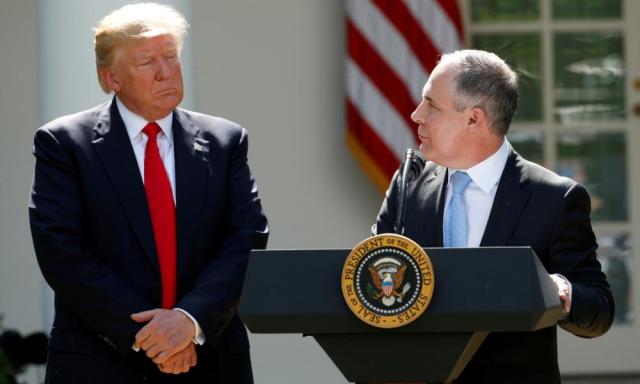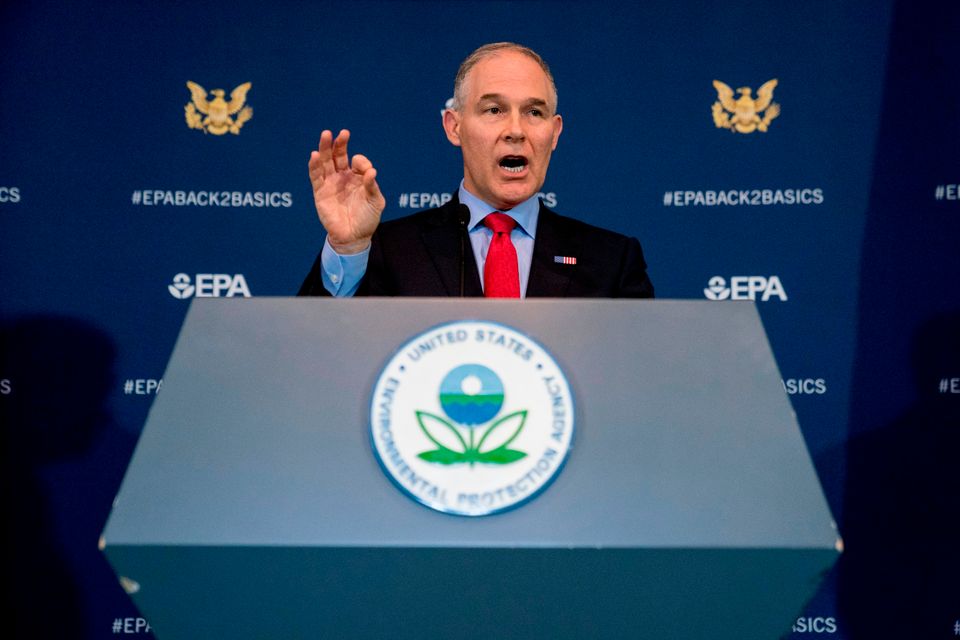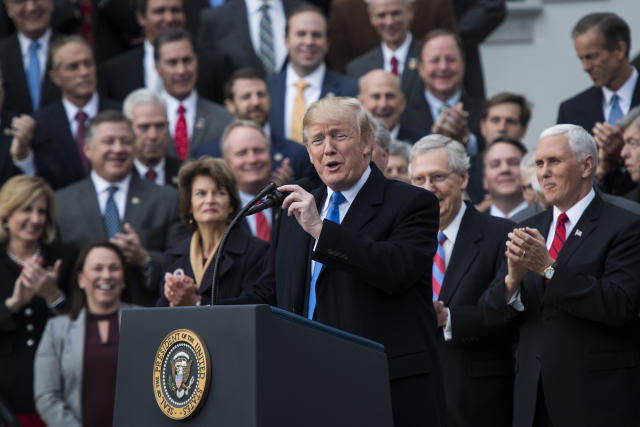ThinkProgress
Fox News host calls on Trump to fire Scott Pruitt
But President Trump still has full confidence in Pruitt.
Natasha Geiling April 23, 2018
 Environmental Protection Agency Administrator Scott Pruitt speaks to the press at a news conference at the EPA on April 2, 2018 in Washington, D.C. Credit: Jason Andrew/Getty Images
Environmental Protection Agency Administrator Scott Pruitt speaks to the press at a news conference at the EPA on April 2, 2018 in Washington, D.C. Credit: Jason Andrew/Getty Images
Environmental Protection Agency (EPA) Administrator Scott Pruitt is facing more friendly fire after this weekend, as a fourth Republican representative along with a Fox News host called on Pruitt to resign following a barrage of scandals.
On Sunday, in response to a question on Twitter, Rep. Frank LoBiondo (R-NJ) said that Pruitt “should resign” and that he was the “wrong fit from the start for [sic] agency dedicated to protecting our environment.”
Frank LoBiondo: Yes EPA Administrator Scott Pruitt should resign. Wrong fit from start for agency dedicated to protecting our environment. #EarthDay2018 reinforces our need to promote pristine planet via clean air & water, leaving it better for future generations. Requires leadership & balance. https://twitter.com/buckeye1960osu1/status/987829657096654853
LoBiondo is the fifth Republican lawmaker, and fourth Republican representative, to call for Pruitt to resign. In the House, Reps. Carlos Curbelo (R-FL), Ileana Ros-Lehtinen (R-FL) and Elise Stefanik (R-NY) have all called for Pruitt to step down. In the Senate, Sen. Susan Collins (R-ME) remains the only Republican to call for Pruitt’s resignation, though a number have expressed concern with Pruitt’s apparent various ethical lapses.
Last week, 170 lawmakers — all Democrats — from both the House and the Senate introduced a resolution calling for Pruitt to resign.
170 lawmakers sign resolution calling for Scott Pruitt’s resignation, including zero Republicans

But Pruitt is also facing fire from outside of the halls of Congress. On Sunday, former adviser to British Prime Minister David Cameron and L.A.-based Fox News host Steve Hilton called for Trump to fire Pruitt, arguing that the EPA administrator has become a walking example of the kind of “swampy” mentality that Trump promised to end.
“What we need is for President Trump to take the lead, fire Scott Pruitt, and throw out the lobbyists from his administration,” Hilton said.
Hilton’s call for Pruitt’s resignation isn’t the first time that Fox News has taken an antagonistic position towards the administrator’s growing canon of scandals.
In early April, Fox News reporter Ed Henry pressed Pruitt on whether he approved raises for two political aides despite the White House not approving those pay increases. Pruitt denied he had knowledge of the raises, but later reporting revealed that Pruitt was privy to the details.
The growing chorus calling for Pruitt’s resignation comes as new information broke late last week about Pruitt’s dealings with a lobbyist couple from whom he rented a room in Washington.
In early April, ABC News reported that for a six month period during his first year as administrator, Pruitt rented a luxury condo on Capitol Hill from the wife of Steven Hart, a prominent D.C. energy lobbyist. Pruitt paid just $50 a night for the condo, and his daughter stayed there for a period of time during the summer while she was interning in D.C. — leading ethics experts to question whether the agreement constituted a gift from the lobbyist family.
Everything we know about Scott Pruitt’s infamous Capitol Hill apartment

Pruitt and Hart maintained that neither engaged in any business between the EPA and any of Hart’s clients while Pruitt was staying in the condo. On Sunday, however, the Guardian reported that Pruitt and Hart did indeed meet at the EPA in July of 2017 (while Pruitt was staying in Hart’s wife’s condo) to discuss efforts to preserve the Chesapeake Bay.
Also on Sunday, White House legislative director Marc Short told NBC’s Chuck Todd that President Trump still has full confidence in Pruitt.
“Scott Pruitt is doing a phenomenal job and the president is happy with him,” Short said on “Meet the Press.”
On Friday, Hart announced that he would be stepping down from his role of chairman at Williams & Jensen, a D.C.-based lobbying firm that represents companies like Exxon and Enbridge.

 President Trump listens to EPA Administrator Pruitt after announcing decision to withdraw from Paris Climate Agreement in the White House Rose Garden in Washington. Photograph: Kevin Lamarque/Reuters
President Trump listens to EPA Administrator Pruitt after announcing decision to withdraw from Paris Climate Agreement in the White House Rose Garden in Washington. Photograph: Kevin Lamarque/Reuters In this April 3, 2018, file photo, Environmental Protection Agency Administrator Scott Pruitt speaks at a news conference at the EPA in Washington. New internal documents say a sweep for hidden listening devices in Pruitt’s office was shoddy and wasn’t properly certified under U.S. government practices (AP Photo/Andrew Harnik,
In this April 3, 2018, file photo, Environmental Protection Agency Administrator Scott Pruitt speaks at a news conference at the EPA in Washington. New internal documents say a sweep for hidden listening devices in Pruitt’s office was shoddy and wasn’t properly certified under U.S. government practices (AP Photo/Andrew Harnik, Credit: Photo by Chip Somodevilla/Getty Images
Credit: Photo by Chip Somodevilla/Getty Images Credit: Joint Committee on Taxation
Credit: Joint Committee on Taxation

 Credit: Saving water – clean natural environment – ocean campaign concept with collaborative woman’s hands in droplet shape on blurred wavy clean water background: Love earth, save water – conceptual idea picture.
Credit: Saving water – clean natural environment – ocean campaign concept with collaborative woman’s hands in droplet shape on blurred wavy clean water background: Love earth, save water – conceptual idea picture. Family Holding Earth in their hands -Earth Day. NASA Image
Family Holding Earth in their hands -Earth Day. NASA Image All adults and children should eat more fruits and vegetables, whether they are organic or conventionally grown. With
All adults and children should eat more fruits and vegetables, whether they are organic or conventionally grown. With 



 Our marine life shouldn’t have to live in a sea of plastic.
Our marine life shouldn’t have to live in a sea of plastic. Greenpeace and MCS (Marine Conservation Society) Mull Beach Clean at Kilninian Beach with pupils from Ulver Primary School, Isle Of Mull. Greenpeace brought its ship the Beluga II on an expedition of scientific research around Scotland, sampling seawater for microplastics and documenting the impact of ocean plastic on some of the UK’s most precious marine life.
Greenpeace and MCS (Marine Conservation Society) Mull Beach Clean at Kilninian Beach with pupils from Ulver Primary School, Isle Of Mull. Greenpeace brought its ship the Beluga II on an expedition of scientific research around Scotland, sampling seawater for microplastics and documenting the impact of ocean plastic on some of the UK’s most precious marine life.